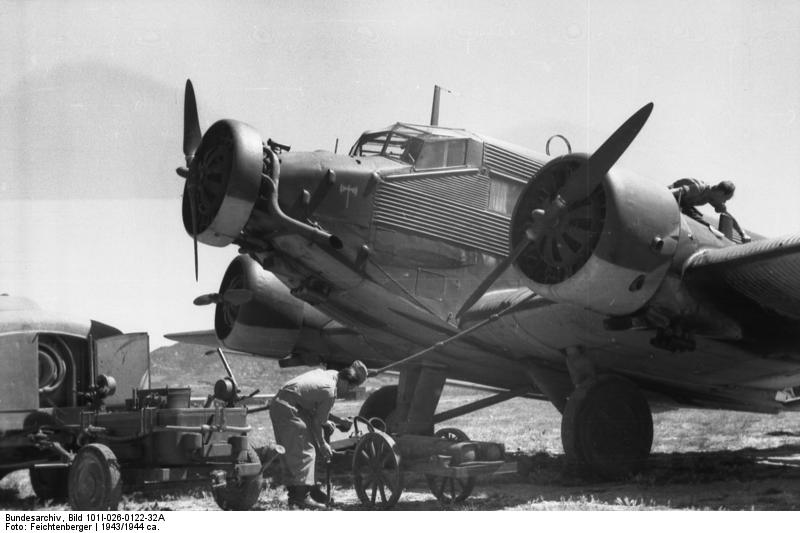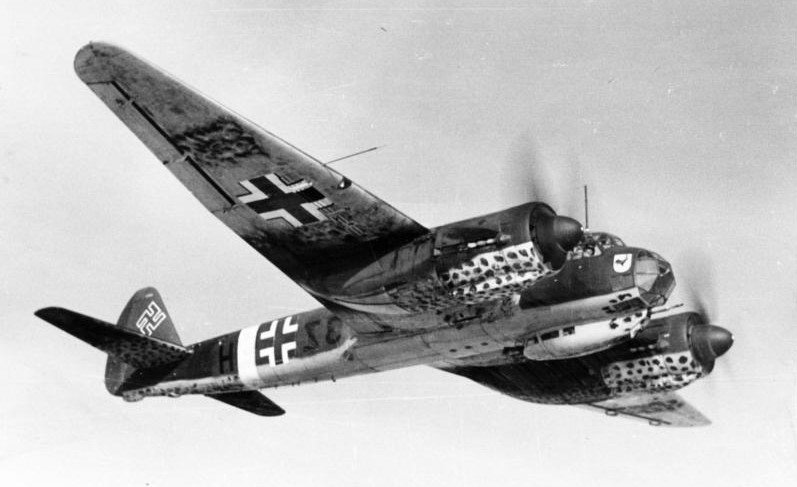Nazis had their sights set on Palestine

Palestine was a battle site for the German Air Force not only in the First World War, but also during the Second. It is well-known that German pilots in the Bavarian flier detachment 304 took extensive aerial photographs of the country in 1917/18. But until now, very little was known about German aerial reconnaissance over Palestine a quarter of a century later.
This is despite the fact that the few attacks launched by the German Luftwaffe in June and July 1941 on the territory of the British Mandate in Palestine, focusing mainly on the port city of Haifa, were styled at the time by Nazi propaganda as the most successful strikes ever against the British presence in the eastern Mediterranean. Haifa was even considered the "main fuelling station" of the British in the region due to its oil pipeline leading from Mosul in Iraq.
Israeli historians Benjamin Z. Kedar and Daniel Uziel have now demonstrated that the German Luftwaffe indeed flew numerous missions over Palestine even before June 1941 and continued to do so until September 1944.
In an article in the Hebrew-language Israeli history journal Cathedra, they analyse no fewer than 286 previously unknown aerial photographs made by the Luftwaffe during the period, which Kedar uncovered in the U.S. National Archives in College Park, Maryland. In an attempt to put together a realistic picture of German air operations at the time, the authors compare the German aerial photographs and their interpretation with records made by the British air defence forces in Palestine ("Hitler's Pilots Photograph Eretz Israel", Cathedra, no. 177, January 2021, Yad Yizthak Ben-Zvi Institute, Jerusalem, in Hebrew).
Crete and Rhodes, crucial for long-range reconnaissance
Palestine only became accessible to the German Luftwaffe after the Wehrmacht's Balkan and Greek campaign in April 1941. The 10th Air Corps under General Heinz Eisler had until then been stationed in Sicily and was now transferred to Greece. Crete was captured by the Germans in late May and could henceforward be used as a base along with Italian-occupied Rhodes. The first German long-range reconnaissance aircraft reached Haifa as early as the following month.

The background behind these initial missions was probably Germany's desire to support the forces of the Vichy regime, which was allied with the Third Reich, in Lebanon and Syria through possible strikes on British targets in Palestine.
And an occasion soon arrived when, on 8 June, the British joined forces with Free French troops to launch the Syria-Lebanon campaign ("Operation Exporter") and the French High Commissioner there, Henri Fernand Dentz, requested support from the Luftwaffe. The Germans complied on the night of 10 June, dispatching some fifty bombers in the direction of Haifa, whose pilots must have been informed of the key targets in that city.
We know this now because three aerial photographs taken on 28 May – the first documented German aerial photographs of what was at the time Palestine – were accompanied by at least two information sheets with the headings "Port" and "Air Base". In addition to the British air base with hangar and seaplanes, other objects were also marked on these sheets in the urban port and industrial area, including "commercial (war) port", "cooling water basin" as well as several "fuel" and "crude oil storage facilities" and also Haifa's railway station and power plant.
The latter was the main target hit by most of the aerial bombs in this first German air raid, which encountered heavy British air defences. The plant sustained only light damage, and the bombs dropped on the port's oil facilities and a residential area on Carmel Hill likewise caused little destruction, because quite a few of them failed to detonate.Two subsequent German bombing missions that took place in connection with "Operation Exporter", which continued until 14 July 1941, also targeted Haifa, but it was only hit once and without any significant consequences. On the second mission, the German pilots – who must have been either in distress or lost – discharged their payload over the city of Tel Aviv, where one bomb killed ten people in an apartment building.

Disrupting "Operation Explorer"
During the British "Operation Exporter" the German Reconnaissance Group 1.(F)/121 flew a total of ten missions. Most of them were directed at Haifa and in two cases also at the neighbouring coastal towns of Acre and Atlit.
On 24 June, a German Ju (Junkers) 88D flew an unusually long route at twelve thousand feet. The plane travelled first from Jaffa to Jericho, then via the British airports in Amman and Al-Zarqa to Tiberias, the site of a British seaplane port, and then on to Haifa. This mission alone – with a flight time of 1 hour and 24 minutes the longest German reconnaissance flight over the area during the Second World War – produced no less than 56 top-quality aerial photographs.
The notes made by the Germans who evaluated them indicate that the potential targets included not only British seaplanes, but also their warships docked in Haifa – indeed, such ships were repeatedly attacked by the Luftwaffe during "Operation Exporter".
Nazi war propaganda celebrated the German Luftwaffe's first attack on Haifa as a further step in a seemingly endless series of German military successes outside of Europe and North Africa. As German planes had massively bombarded Alexandria shortly before, the bombing raid was glorified as a vital advance into the area controlled by the British in the eastern Mediterranean.
As a direct consequence of the "victory in Crete", the British now purportedly no longer had a base outside the "danger zone of the German Luftwaffe". And in reports on the bombardment of Haifa the Nazi press exaggerated that major damage had been wrought by "explosions in fuel depots and port facilities".

Embedded media feeds the propaganda machine
Soon not only aerial photographs taken by the long-range reconnaissance aircraft were appearing in German newspapers, but also accounts written by war reporters who had been on board for the reconnaissance flights.
Along with one such article entitled "Night Flight over Haifa", which appeared on 19 July 1941 in Adler von Hellas, the newsletter of the 10th Air Corps, the historian Daniel Uziel discovered in the German Federal Archives a particularly dramatic eyewitness account by the well-known Nazi war correspondent Heinz Liebscher.
He had been sitting on the floor of a Ju 88D for a reconnaissance flight over Haifa on 9 July 1941 and in case of emergency was supposed to spring into action as front gunner. In his report, presumably never published, Liebscher gives free rein to his imagination in describing the damage that previous air raids had allegedly caused to Haifa's oil installations, enthusiastically remarking: "Our bombers did a flawless job!"
This was followed by a description of a heroic dogfight in which Liebscher's plane, having already been fired on by British anti-aircraft guns, was attacked by a group of Hurricane fighters. Liebscher claimed to have manned the machine gun: "I returned the fighter's fire as calmly as possible. I managed to empty a whole barrel into the Hurricane. Then the danger was over!"
Yet another dogfight had to be mastered according to this version; however, no mention can be found of these allegedly so dramatic events in the records of the British air defence – which noted only that some fighters had taken off. In fact, the British fighter pilots were not even capable of reaching the height at which the German reconnaissance planes flew with the flight technology available at that time.
With the launch of the Wehrmacht's invasion of the Soviet Union in the summer of 1941, German reconnaissance flights over Palestine became less frequent. In addition to Haifa, the Luftwaffe now seemed to take an interest in British positions in and around Gaza and Aqaba on the Red Sea. We can surmise that this focus was related to plans to extend the African campaign towards Egypt.
In any case, the advance of the Africa Corps under Rommel towards the land on the Nile was accompanied by much more frequent German long-range reconnaissance flights over Palestine. Fourteen such missions are documented for the period between the end of June 1942 and the German defeat at El Alamein on 9 November 1942.
Unique pictorial record
As well as Haifa's strategic installations, which were photographed from the air several times as part of a support operation for a planned Italian submarine attack, the eyes of the German reconnaissance pilots now zeroed in on objects beyond the British air bases in southern and northern Palestine. On 9 October 1942, a photograph was also made of the massive British defensive line north of the coastal town of Nahariya on the border with Lebanon. This is the only known aerial shot of this rampart, whose deep anti-tank ditches were probably originally intended to repel a possible German advance from the Caucasus region.

According to the newly discovered aerial photographs, the German Luftwaffe, which since the Dodecanese campaign in the autumn of 1943 was also able to operate from the south-eastern Aegean, flew a total of twelve missions over Palestine from December 1942 to September 1944. In April 1943, the only reconnaissance plane (Ju 88D-1) to be lost by the Germans over this area during the war was shot down over Acre.
Alongside the targets that were usually photographed, shots of Tel Aviv and environs taken during these missions stand out. The Israeli historians have not been able to clarify whether these were connected with the proposal made several times by the Palestinian Grand Mufti Amin al-Husseini, who was in Berlin at the time, that cities in Palestine should be bombed, or were perhaps the result of similar considerations on the part of German Air Force Command.
Whatever their motivation, the 286 aerial photographs discovered show that British-controlled Palestine interested German military reconnaissance to a far greater extent than previously realised. At the same time, they also provide otherwise unavailable pictorial documentation from this period – not only of many locations in Palestine, but also of the military installations maintained there by the British, who only began to systematically photograph the country from the air at the end of 1944.
© Qantara.de 2021
Translated from the German by Jennifer Taylor